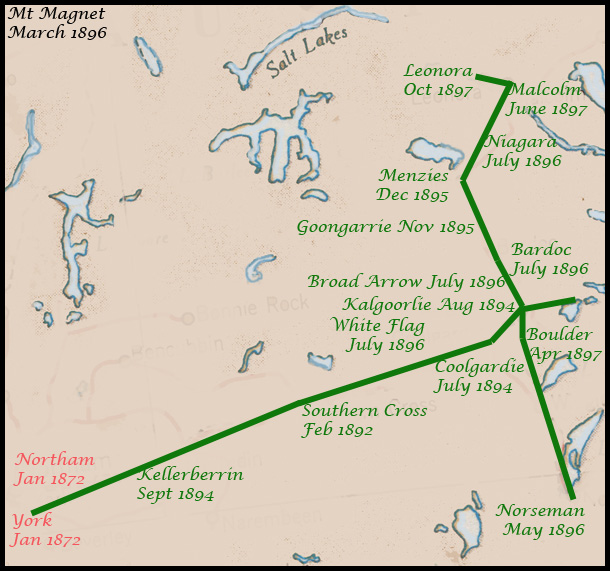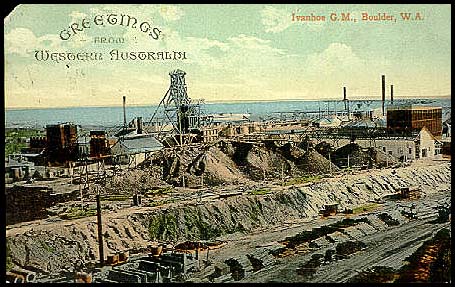Telegraph lines to the Goldfields Region.
- Australia 1901-1988
- New South Wales
- Queensland
- South Australia
- Tasmania
- Victoria
- Western Australia
- International
- Special aspects
The Goldfields Region is defined, for the purposes of describing the construction of telegraph lines to the Goldfields, as extending:
- from the junction of the Mid West and Wheatbelt regions east of Southern Cross;
- to beyond Boulder and Bardoc in the east to the South Australian border;
- from Mount Sir Samuel, Lawlers and Leonora in the north;
- to beyond Norseman in the south.
- it stops north of Esperance but includes Ravensthorpe so that the line to South Australia can be discussed coherently.
The small map below represents an area of about 230,000 km2 - about twice the size of England, three times the size of Austria and five times the size of Switzerland.
 |
All construction of the telegraph lines in the region took place in the 1890s. The first discoveries of gold in the Yilgarn region had occurred in 1887 and gold rushes followed at Southern Cross in 1888, Coolgardie in 1892 and Kalgoorlie in 1893. York was the Telegraph Office in the west from which the line extensions were developed. The area was very remote even for those early days - the road from York to Southern Cross through the Yilgarn region was only constructed in the last 3-4 months of 1890.
|
The second session of the first Parliament under Responsible Government was opened on Monday 7 December 1891 by His Excellency the Administrator and in his speech he noted that the 162 mile telegraph line from York to Yilgarn was being erected and would be completed soon.
The West Australian of 2 February 1892 reported "The Southern Cross telegraph line has not yet been opened. It appears that from some unascertained cause - possibly an accident to the wire or the non-arrival of the operator at the fields - communication has not been commenced by the Government. Consequently it was not found possible to open the line to the general public yesterday as was at first intended".
The Telegraph Office was opened at Southern Cross on 4 February 1892. There are few details available on this construction but there appears to have been some odd decisions according to some letters published in the Western Mail.
The gold discoveries were of world-wide interest and the overseas press commented on developments regularly. The Colonist Press in Vancouver, Canada carried the following on 15 February 1894:
"There is something striking and theatrical in these West Australian gold finds. The richness of some of them is indisputable, and their permanency seems a reasonable assumption to experts. But the accidents of discovery are romantic.
A man falls over a big stone , strikes it maliciously with his pick in the anger of a bruised shin, and reveals a mass of gleaming gold. Chunks of gold, bars and pillars and blocks of gold are what the telegrams speak of, not merely good prospects or the absolute certainty of payable returns. The latest big sensation is the discovery of a rich reef in the back yard of a hotel in the main street of Coolgardie. This ought to be the greatest money-making concern in the world-for the publican, who will have a double gold mine on the premises."
| For reasons now unknown, construction appears to have been suspended for two years until survey work resumed in February 1894 and commencing from Southern Cross with the aim of extending the line to Coolgardie. Construction was completed to Coolgardie in July 1894 and to Kalgoorlie in the following month.
By September, the traffic on the line was so heavy that the lines were overloaded, there were delays in sending and receiving and the operators were requesting a duplex instrument as well as a duplication of the lines. A duplicate line was built from Perth to Coolgardie but as early as December 1895, the poor quality of this overcrowded line was already being noted in the Press as well as comments that it was falling down in several places. At about the same time, an intermediate Office was opened at Kellerberrin closer to York. It was opened at the newly established railway office which resulted in the town being relocated about 5 kms south so that residents could be near the railway. |
 The Ivanhoe Gold Mine at Boulder about 1900. |
At the same time, the railway was being constructed to link from Perth to Yilgarn and then to Southern Cross and Coolgardie. The Loan Act of 1894 had appropriated £228,000 to construct the railway line to the Coolgardie goldfields. By September 1895, the Legislative Assembly, when discussing item 2 of the Loan Bill, required the funds to cover the additional 25 miles to Kalgoorlie and moved that the reference to "the railway from Southern Cross to Coolgardie" should be taken to include "the railway from Coolgardie to Kalgoorlie" (Western Australian, 11 September 1895). A week later the Coolgardie-Kalgoorlie Railway Bill was passed.
Construction of the railway from Southern Cross to Coolgardie was as follows:
- 24 August 1894: the first 20 mile section was opened;
- 16 September 1895: the second 23 mile section was opened to Koorarawalyee;
- 11 October 1895: the third section of 20 miles was opened to Boorabbin;
- 6 December 1895: the fourth section (giving a total of 75 miles) was opened to Woolgangie;
- 31 January 1896: line completed to Coolgardie;
- 16 February 1896: the contractors were preparing the site for the Coolgardie Railway Station at the Police Reserve at the top of Hunt Street so as to be ready for the line from Bullabulling expected in about three weeks. The contractor arrived on 27 February.
- 22 March 1896: the line had been laid to within half a mile of the station;
- 23 March 1896: the opening ceremony for the Coolgardie Railway was held - see Report.
On 17 January, 1896, Mr. Samuel Oliver, the Government Inspector of the Southern Cross - Coolgardie railway construction works, "was found dead at Roen's Soak siding after evidently being run over by a train".
On 8 February 1896, the telegraph line to Kurnalpi (NE of Boulder) was completed.
Many mines opened in the area over the next few years. About 700 companies operating in this area were listed on the London Stock Exchange. Lines were extended to Norseman in 1896 and to Malcolm (more than 200 miles from Coolgardie) and to Leonora by 1897.
The contract for the distribution of telegraph material for the line from Niagara to Lawlers was awarded to the firm of Faiz and Tagh Mahomet. The construction of the line, which was carried out by the Government, was completed as far as Mount Malcolm in April 1897. The West Australian of 31 August 1897 reported:
"Mr. W. H. McGregor, the post master at Lawlers, wired the Postmaster-General yesterday that the telegraph line between Niagara and Lawlers had been completed and that the office connection had been fixed at 6 o'clock on Sunday afternoon (29th). The wire also stated that the line was working satisfactorily and that the inhabitants were gratified at the completion of the work".
The Inquirer of 10 July 1896 reported that residents are indignant at the action of the Minister in recommending a telegraph line from Mount Magnet to Menzies, via Mount Malcolm, instead of via Mount Malcolm and Lawlers. If this route were taken it would meet the requirements of almost the whole of the East Murchison district, whereas the proposed line takes in a very sparsely populated country. It is recommended here that the Minister be asked to reconsider the matter, and grant a line as suggested.
The only other construction work in the region was to connect new stations on or close to the existing line. Many of the larger mines were connected with their own telegraph station (see Table).
The Adelaide Register of 26 October 1910 reported that "In the House of Representatives on Tuesday (25th) Mr. Mahon (W.A.) drew attention to the great rush to the Bullfinch Goldfield and urged the immediate construction of a telegraph line from Southern Cross. The Minister for Customs (Mr. Tudor V.) said extra telegraph operators had been sent to Southern Cross and personal investigations were being made in regard to what was required".